7 Amirs, 30 Amir's Mamluks, 6 Halqa commanders, 53 Halqas, unknown volunteers Heavy End date May 18, 1291 Location Acre, Israel | Start date 1291 Result Mamluk victory | |
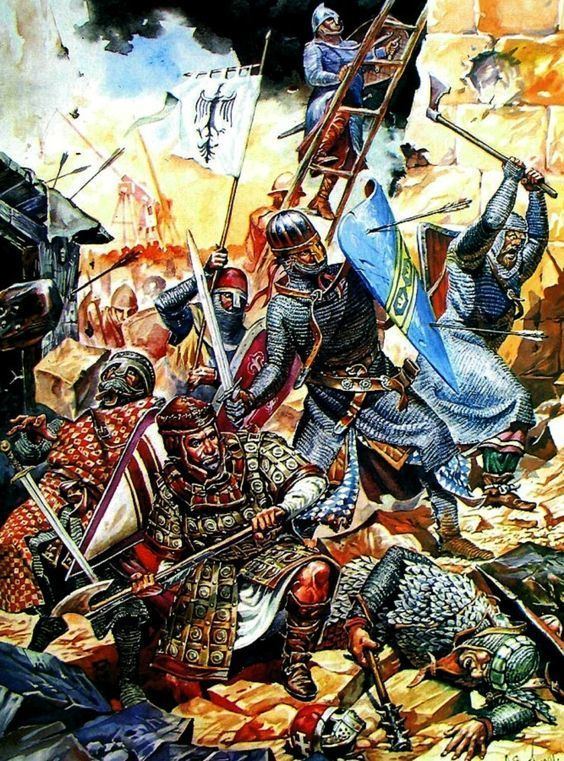 | ||
220,000 17,000 infantry,1,100 cavalry Similar Crusades, Siege of Jerusalem, Battle of Arsuf, Fifth Crusade, Second Crusade | ||
Siege of acre 1291
The Siege of Acre (also called the Fall of Acre) took place in 1291 and resulted in the loss of the Crusader-controlled city of Acre to the Mamluks. It is considered one of the most important battles of the period. Although the crusading movement continued for several more centuries, the capture of the city marked the end of further crusades to the Levant. When Acre fell, the Crusaders lost their last major stronghold of the Crusader Kingdom of Jerusalem. They still maintained a fortress at the northern city of Tartus (today in north-western Syria), engaged in some coastal raids, and attempted an incursion from the tiny island of Ruad, but when they lost that as well in 1302–3 in the Siege of Ruad, the Crusaders no longer controlled any part of the Holy Land.
Contents
- Siege of acre 1291
- Background
- Defensive efforts
- Muslim attack on the city
- Siege
- Amassing of forces
- Call for aid from Europe
- The defences
- The siege begins
- Parley
- The towers begin to fall
- Acre falls
- Aftermath
- In fiction
- References
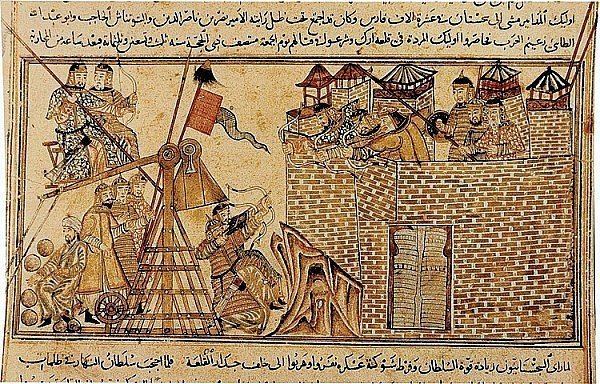
Siege of acre 1291
Background
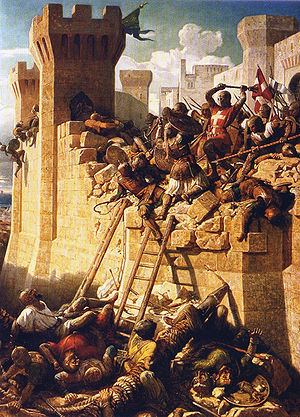
The main turning point in the Crusades was in 1187 when, after the pivotal Battle of Hattin, the Christians lost Jerusalem to the forces of Saladin. In the same year, Saladin was able to conquer a great part of the Kingdom of Jerusalem including Acre and Jerusalem. This led to the Third Crusade, during which Acre was besieged and eventually fell in the hands of the Christians in 1191; it became the base of operations and capital of the Kingdom of Jerusalem for most of the next hundred years. The religious orders had their headquarters in or near Acre, from which they made crucial decisions in military and diplomatic efforts. For example, when the Mongol forces came in from the East in the mid-13th century, the Christians saw them as potential allies, but also maintained a position of cautious neutrality with the Muslim forces of the Mamluks. In 1260, the Barons of Acre allowed the Mamluks to pass through their territory unhindered, which enabled the Mamluks to achieve a decisive victory against the Mongols at the pivotal Battle of Ain Jalut in Galilee.
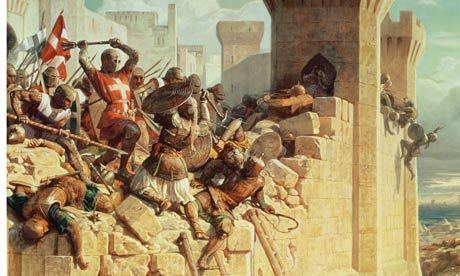
However, most relations with the Mamluks were not as cordial. With the rise of the Mamluk Sultanate in Egypt in 1250, an even more dangerous and formidable enemy than the Ayyubids with heavy cavalry to match Crusader knights, the destruction of the remaining Crusader territories gathered pace. They also proved to be much more hostile. After the Battle of Ain Jalut, Mamluk forces began attacking Crusader holdings as early as 1261 under Sultan Baibars. In 1265, Caesarea, Haifa, and Arsuf all fell to the Sultan. The following year saw the loss of all the important Latin holdings in Galilee. In 1268 Antioch was taken.
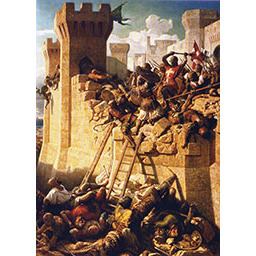
To help redress these losses, a number of minor Crusading expeditions left Europe for the East. The abortive Crusade of Louis IX of France to Tunis in 1270 was one such attempt. The minor Ninth Crusade of Prince Edward (later King Edward I) of England in 1271–1272 was another. Neither of these expeditions was capable of giving any sound assistance to the beleaguered Latin states. The forces involved were too small, the duration of each of the Crusades too short, the interests of the participants too diverse to allow any solid accomplishment.
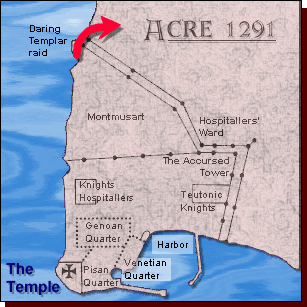
Pope Gregory X labored valiantly to excite some general enthusiasm for another great Crusade, but he labored in vain. The failure of his appeal was variously ascribed by the Pope's advisors to the laziness and vice of the European nobility and to clerical corruption. Though each of these factors may have been in part to blame, a more basic reason for the failure seems to have been the debasement of the ideal of the Crusade itself. The use by Gregory X's predecessors of the label and privileges of the Crusade to recruit armies which could fight the Papacy's European enemies had done much to throw the whole movement into disrepute.
In any event, no Crusade of any major importance was forthcoming, despite the Pope's best efforts. Meanwhile, the attacks on the Latin East continued, as did also the internal difficulties within what was left of the Latin Kingdom. By 1276, the situation, both external and internal, had become so perilous that the "King of Jerusalem" Henry II withdrew from Palestine altogether to take up his abode on the Island of Cyprus. The desperate plight of the Latin Kingdom worsened. In 1278, Lattakia fell. In 1289 Tripoli was lost in the Fall of Tripoli.
The Mamluks were led by Sultan Al-Ashraf Khalil, son of Qalawun. Qalawun had begun preparations for the siege but died in November 1290.
Defensive efforts
Decades of communications between the Europeans and the Mongols, towards the possibility of creating a Franco-Mongol alliance, had not produced any noticeable result, and attempts to raise a new army from Italy merely gave an excuse for the final attack by the Muslims.
Muslim attack on the city
Following the fall of Tripoli, king Henry of Cyprus sent the senechal Jean de Grailly to Europe to warn European monarchs about the critical situation in the Levant. Jean met with Pope Nicholas IV who shared his worries and wrote a letter to European potentates to do something about the Holy Land. Most however were too preoccupied by the Sicilian question to organize a Crusade, as was king Edward I too entangled in troubles at home.
One Arabian account claims that an affair between a rich young wife of the city and a Mussulman was discovered by the husband who:
gathers together some friends goes out from Ptolemais [...] and immmolates them both to his injured honour. Some Mussulmans are drawn to the spot, the Christians come up in still greater numbers, the quarrel becomes angry and general and every Mussulman is massacred.
The Christians feared this would give the Sultan a pretext on which to renew the war and petitioned the pontiff to send further aid. The aid according to Michaud came in the form of 25 Venetian galleys carrying 1600 men "levied in haste in Italy". Other sources claim 20 galleys of men to be peasants and unemployed townfolks from Tuscany and Lombardy led by Nicholas Tiepolo, the son of the Doge, who was assisted by the returning Jean de Grailly and Roux of Sully. These were then joined by five galleys from king James II of Aragon who wished to help despite his conflict with the Pope and Venice.
These reinforcements from Italy were ill-disciplined and having no regular pay resorted to pillaging indiscriminately from both Muslims and Christians before setting out from Acre. According to Runciman they attacked and killed some Muslim merchants around Acre in August 1290 though Michaud's account reports that they instead laid waste towns and villages all about with pillaging and massacre. In any case if the Sultan Qalawun were in need of a further pretext for attack he certainly now had one — Qalawun asked for the men guilty of the killing to be remitted to him so that he could apply justice. After discussions of the apparent remitting the Christian criminals from Acre's jails, an idea of Guillaume de Beaujeu, the Council of Acre finally refused to remit anybody to Qalawun, and instead tried to argue that the killed Muslims had died because of their own fault.
Although a ten-year truce had been signed in 1289, Qalawun deemed the truce void following the killings. By October, Qalawun had ordered a general mobilization. Though the Sultan died in November, he was succeeded by his son Khalil (some accounts Chalil), who would lead the forces attacking Acre.
Siege
Qalawun, father of Khalil, conquered the County of Tripoli in 1289, and in 1290 marched on Acre, the capital of the remnant of the Kingdom of Jerusalem, but, to the relief of the Franks of Acre, he died in November before launching the attack. He was succeeded by Khalil who decided to continue the attack. Khalil sent a message to William of Beaujeu, the Master of the Temple, telling him about his intentions to attack Acre and urging him not to send messengers or gifts. But a delegation from Acre led by Sir Philip Mainebeuf, arrived in Cairo with gifts and appealed to Khalil not to attack Acre. Khalil did not accept the request and imprisoned the Frank messengers.
Amassing of forces
Al-Ashraf Khalil assembled the forces of Egypt and Syria, which included a great number of volunteers and siege engines from everywhere at Hisn al-Akrad. Some of Khalil's catapults were huge and had such names as "Al Mansuri" and "The Furious" in addition to lighter, but potent, mangonels called "Black Bulls". Four armies from Damascus (led by Lajin), Hama (led by al-Muzaffar Taqai ad-Din), Tripoli (led by Bilban) and Al-Karak (led by Baibars al-Dewadar) marched to Acre to join the Muslim army of Khalil.
In addition to the historian Baibars al-Dewadar who led the army of Al Karak, Abu al-Fida was another prominent historian who accompanied al-Ashraf in his Levantine expedition.
Call for aid from Europe
The Franks of Acre were for some time aware of the seriousness of the situation. They asked for help from Europe which resulted in nothing significant. A small group of knights, among them the Savoyard Otto of Grandson, were sent by King Edward I of England. Burchard of Schwanden, the Grand Master of the German Teutonic Knights, resigned and was replaced by Konrad von Feuchtwangen who suddenly left Acre for Europe. The only noteworthy reinforcement came from king Henry II of Cyprus who fortified the walls and sent forces led by his brother Amalric to defend the city.
The defences
Acre was well defended by two lines of thick walls and had twelve towers which were built by European kings and rich pilgrims.
The siege begins
On 5 April 1291, Khalil's forces stood in front of Acre. The army of Hama took its position on front of the Templars' tower, while the Muslim army stretched out from the end of the wall of Montmusard up to the Gulf of Acre. The Dihliz (red tent of the Sultan and the headquarters) stood on a small hill near the shore on front of the Tower of the Legate. For eight days both armies engaged in occasional clashes. At the end of the eight days the Muslims set up barricades and began to move further towards the city, using wicker screens, till in the end they reached the edge of the wall, while continuously bombarding the walls with trebuchets. Carabohas were brought up and parts of the wall were mined out. Despite the continual arrival of reinforcements from Cyprus to Acre by sea, the Franks became convinced of their lack of strength against Khalil's army. On 15 April, under moonlight, the Templars, led by Jean Grailly and Otto of Grandson, launched a sudden attack against the camp of the contingent of Hama, but their horses got their legs tangled in the ropes of the Muslims' tents and were caught, and many were killed. Another attack, after a few days and this time under cover of darkness, by the Hospitallers also ended badly. On 5 May, some hope was revived when Henry II of Cyprus arrived with forces transported by 40 ships. But soon Henry, too, became convinced of his helplessness.
Parley
The Franks sent messengers to Al-Ashraf Khalil who saluted him on their knees. Khalil asked them whether they brought him the keys of the city, but they replied that the city could not be surrendered so easily and that they only came to plea for mercy for the poor inhabitants and that the Franks were willing to discuss any injustice done by them earlier to the Muslims and to restore the truce signed by them and the Muslims. Khalil promised the messengers to spare the life of everyone if the Franks hand him Acre peacefully, but the messengers refused his offer. While the messengers were still there a huge catapult stone launched from the city struck the ground near the sultan's tent. Khalil, believing that the crusaders were negotiating in bad faith, reacted furiously and wanted to kill the two messengers, but Emir Sanjar al-Shuja' pleaded for them and they were sent back to the city.
The towers begin to fall
From 8 May, Acre's towers began to cave in one after one. On 18 May (4 May according to Michaud), early in the morning at sunrise, the Sultan gave his order to launch an all-out attack on all points, accompanied by sound of trumpets and drums carried on 300 camels. Nightfall gave some relief to the defenders causing the Saracens to retreat and allowing the King of Cyprus, Henry, the chance to escape (under the pretence of seeking repose) with his knights and 3000 soldiers.
By morning the attack had resumed; noticing the lack of Cypriot defence at the tower and gate of St. Anthony, Khalil ordered his Chages to fill up a ditch to allow the cavalry access. The Chages, sectaries to the Mameluks and known for self-immolation in the name of Islam, followed the order with their living bodies forming a bridge over which the cavalry advanced and gained the foot of the walls.
The Muslim forces advanced towards the Accursed Tower and forced the Frankish garrison to retreat to the side of the Gate of St. Anthony. All counter-attacks and attempts made by the Hospitallers and the Templars to recapture the tower were in vain. King Henry II and the Master of the Hospital boarded their galleys and fled from Acre. William of Beaujeu, the Master of the Temple, and Matthew of Clermont were killed. By capturing these positions, the Muslim forces were now inside the city fighting the Franks in the streets and alleys of Acre, which turned into a terrifying chaos as the inhabitants were fleeing towards the sea. How many inhabitants perished on land and in sea is unknown.
Acre falls
Before night on Friday 18 May 1291, Acre, after being in the hands of the Franks for 100 years, was in the hands of Al-Ashraf Khalil and his army after a siege of 43 days, with the exception of the huge headquarters of the Templars which stood on the west side of the city seashore. After a week, Al-Asraf Khalil negotiated with Peter de Severy, who was in charge of the Templars, and it was agreed that the Templars and everyone inside the fortress would have free passage to Cyprus, but the Sultan's men who were sent to the fortress to supervise the evacuation seemed not disciplined enough to handle the matter and were massacred by the Templars. Under the cover of darkness, Thibaud Gaudin, the new Master of the Temple, left the fortress for Sidon with a few people and the fortune of the Templars. In the morning, Peter de Severy went to the Sultan to settle a new negotiation but he was arrested with his followers and they were executed in retaliation for the Sultan's men who were massacred earlier by the Templars inside the fortress. When the besieged Templars in the fortress saw what happened to Peter de Severy, they continued the fight. On 28 May, after a wide breach was made under the fortress, the Sultan sent about 200 men to take it. The Frankish fortress collapsed, killing nearly everyone inside. All the Templars were killed, and about half of the Sultan's men were killed.
The news of the conquest of Acre reached Damascus and Cairo. Al-Ashraf Khalil entered the decorated city of Damascus with Franks chained at the feet and the captured crusader standards which were carried upside-down as a sign of their defeat. After celebrating his victory in Damascus, Khalil left for Cairo, which was also decorated and celebrating. Arriving at Cairo, he ordered the release of Philip Mainebeuf and the men who accompanied him to Cairo earlier.
Aftermath
The fall of Acre signaled the end of the Jerusalem crusades. No effective crusade was raised to recapture the Holy Land afterwards, though talk of further crusades was common enough. By 1291, other ideals had captured the interest and enthusiasm of the monarchs and nobility of Europe and even strenuous papal efforts to raise expeditions to retake the Holy Land met with little response.
The Latin Kingdom continued to exist, theoretically, on the island of Cyprus. There the Latin kings schemed and planned to recapture the mainland, but in vain. Money, men, and the will to do the task were all lacking. One last effort was made by King Peter I in 1365, when he successfully landed in Egypt and sacked Alexandria. Once the city was pillaged, however, the Crusaders returned as speedily as possible to Cyprus to divide their loot. As a crusade, the episode was futile, and this and further coastal raids over the following decades led in 1410–11 to a destructive counter-raid by the Mamelukes; in 1426 Cyprus was forced into Mameluke vassalship with a hefty yearly tribute.
The 14th century saw some other crusades organized, but these enterprises differed in many ways from the 11th- and 12th-century expeditions which are properly called Crusades. The crusades of the 14th century aimed not at the recapture of Jerusalem and the Christian shrines of the Holy Land, but rather at checking the advance of the Ottoman Turks into Europe. While many of the crusaders in these 14th-century undertakings looked upon the defeat of the Ottomans as a preliminary to the ultimate recapture of the Holy Land, none of the later crusades attempted any direct attack upon Palestine or Syria.
In fiction
The siege of Acre is covered in the Robyn Young historical novel “Crusade”, published in 2007.
